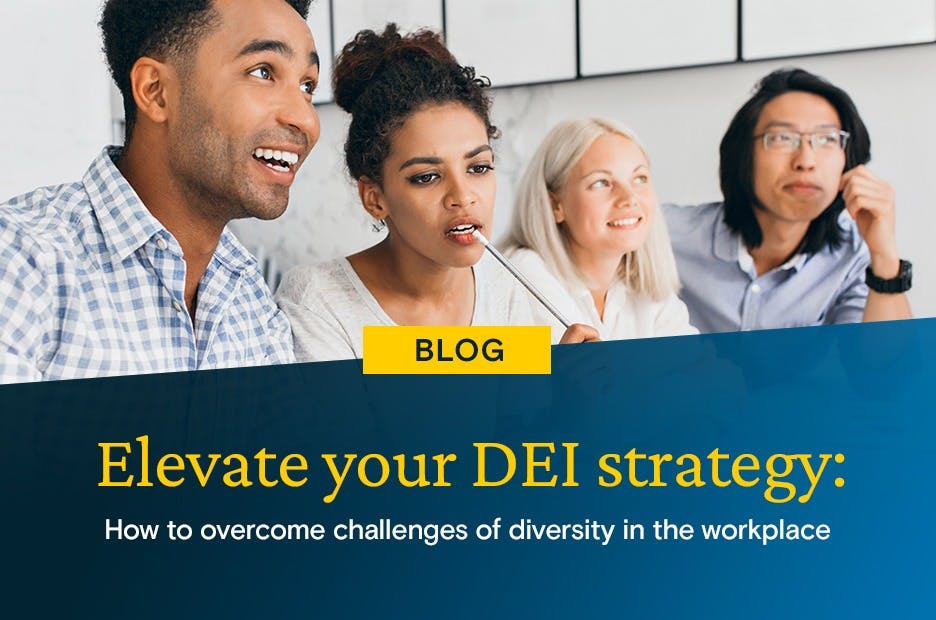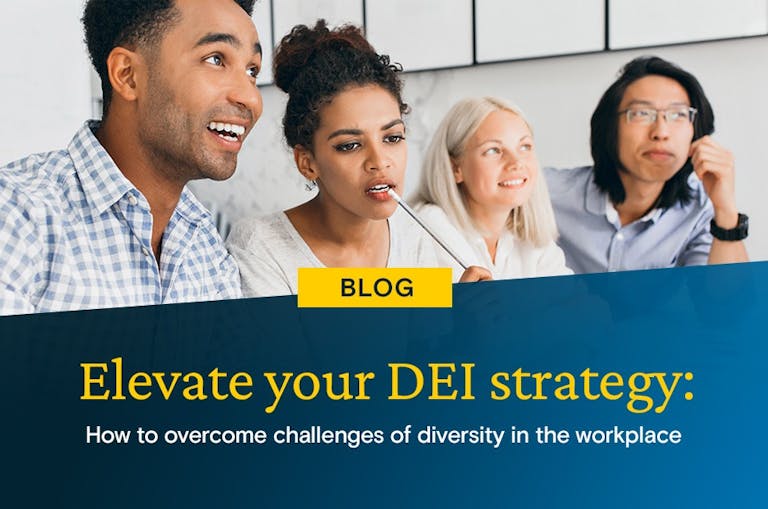Systemic barriers prevent many under-represented individuals from reaching their highest potential both academically and in the workplace. One study from the National Center for Education Statistics demonstrates that while 68% of white Americans over the age of 25 have sufficient education to allow access to quality jobs, the same is true for only 55% of Black Americans and 39% of Latinx Americans.
With these inequities at the forefront of the discussion around diversity, equity and inclusion (DEI) in the workplace, there’s a spotlight on businesses to take action and lead the change towards a better future. However, even the largest companies with countless resources still struggle to nail down a DEI plan that’s effective at driving real business outcomes.
Although you likely already have robust processes in place to address workplace DEI, it’s important to evaluate these efforts on an ongoing basis to ensure their effectiveness. In this article, we take a closer look at some of the most common challenges of diversity in the workplace and how you can evolve your strategy to overcome them.
Barriers to diversity in the workplace
When evaluating your DEI efforts, it’s important to start from a place of awareness. This begins with understanding the various barriers to workplace diversity, including:
- Unconscious bias
What makes workplace DEI particularly challenging to address is that many harmful behaviors exist at an unconscious level. This might include unfair or untrue ideas about the competency of an individual based on characteristics such as their age, gender, sexuality, culture, race or educational background among others. These unconscious biases help to perpetuate an inequitable status quo, which then can seep into all aspects of the company culture and negatively impact the overall work environment. - Microaggressions
A microaggression is a subtle, sometimes unintentional derogatory comment or gesture. Although anyone can be a target of microaggressions, these insults are commonly targeted at people from marginalized groups. Over time, these subtle negative behaviors can lead to conflict and contribute to a hostile work environment. - Workplace inequity
When discussing diversity and inclusion in the workplace, equity is often overlooked or misunderstood. Having an equitable work environment means recognizing that every employee has varying access to resources and some individuals may require additional support to take advantage of opportunities within the organization. If some team members don’t feel that they’re on the same level playing field as others, it can be detrimental to your greater diversity and inclusion efforts. - Lack of diverse representation
People want to see others like themselves reflected in all levels of a company to trust that they have a viable opportunity to advance and believe that their employer values diversity. If the majority of your leadership team is homogenous, it can send a message to those who don’t fit the mold that reaching that level of leadership is unattainable to them. - Lack of inclusion
Inadequate inclusion efforts have the potential to alienate anyone who does not already fit the culture of a company. This can lead to disengaged employees and ultimately, stagnate organizational growth.
On the other hand, inclusive businesses are 1.7 times more likely to be leaders in innovation and can earn 2.3 times more revenue per employee.
How to overcome challenges of diversity in the workplace
There’s no doubt that managing an ongoing DEI strategy is challenging. And there’s not one surefire solution or process that guarantees success. The organizations that are the most effective at managing diversity are the ones that revisit their efforts on an ongoing basis and continuously evaluate new (or existing) tactics to find ones that will move the needle.
Barriers to diversity will always exist, but here are some actionable steps you can take today to work towards overcoming them:
- Proactively address barriers to education inequity
Many leading organizations are leveraging workforce education to support diversity, equity and inclusion progress. By providing employees with access to quality education, you empower all team members to reach their full potential and earn the credentials and/or skills needed to grow with your company. This leads to a more equitable and inclusive work environment and can generate key business outcomes such as improved retention. - Think beyond DEI training
By now, most companies have implemented some form of diversity, equity and inclusion training. Although it can be a powerful tool for generating awareness around key DEI issues, training alone is not enough to foster lasting organizational change. Instead, consider integrating training with another initiative, such as a mentorship program. This allows employees to have a dedicated time and space to have open and honest conversations with their colleagues about their learnings. - Evolve your hiring practices
Hiring places a major role in furthering DEI within an organization. And although hiring for diverse talent is likely already a major priority for your talent acquisition team, it’s important to remember that your diversity recruiting strategy should never be static.
For example, many businesses have shifted to a skills-based approach to hiring that prioritizes past experience and competencies over degree requirements. This allows you to recruit from a wider pool of qualified job candidates that may not have had access to quality education or followed a traditional path to education.
Additionally, be sure to keep a pulse on the latest diversity-specific job boards and talent initiatives that can help your team connect with a wider pool of diverse job seekers, such as OneTen. - Integrate DEI into company culture
Although advancing DEI is a responsibility that falls on all members of the organization, it starts with company leadership. The most diverse organizations view DEI as more than just a series or policies or people programs. Instead, the standard is set by the everyday behaviors and actions of the people in leadership and the work environment that they cultivate.
The need for better diversity, equity and inclusion practices in the workplace has never been more clear. And while the benefits of DEI far outweigh the costs, there are still barriers in place that make the road to better diversity undeniably challenging. It’s the responsibility of corporate leadership to meet these challenges head-on and continuously work to evolve existing strategies.
Unlock more DEI resources: Education is a powerful tool for breaking down barriers to diversity. Download the guide to learn how a dedicated workforce education program can support your DEI goals.


